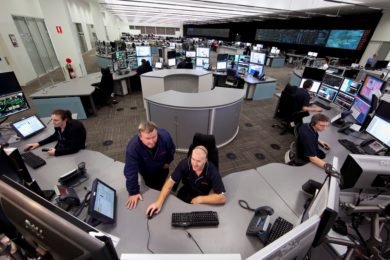“Tony Maurice trains newbies to drive haul trucks and operate heavy mining machinery in a space so friendly the only risk is spilling their coffee. Safely tucked away in a simulator module some distance from the pit, Tony’s rookie operators are comfortable in the knowledge that an error won’t cost millions of dollars or result in injury. It’s a far cry from when 30-year mining industry veteran Tony himself learned to drive.”
“For the first load they put me in the passenger seat of an 85 t haul truck. For the second load I was in the driver’s seat. And then I was off on my own,” remembers Tony, who is based in the Pilbara, the heart of Rio Tinto’s Australian mining operations. “There were no qualified trainers back then. You were just put into the first truck that came past and expected to learn on the job.”
Tony was passionate about finding a better way to learn and was inspired to become a trainer himself. He has helped Rio Tinto pioneer the use of simulators to prepare operators for the field. An ingenious interlinking of a computer, screen and tactile equipment: simulators put operators in the cabin of a truck or excavator then throw at them everything they can expect of the job – and a few things they don’t expect. “Learning to operate a piece of heavy equipment in the hustle and bustle of a mine, with horns tooting and machines moving all around them can be incredibly stressful,” says Tony. “Simulators remove that anxiety and create more suitable conditions for learning. They also allow us to challenge more experienced operators with emergencies that even industry veterans have not encountered.”
Cy Bettjeman, also a Pilbara-based trainer with long experience in mining, says technology is revolutionising the industry. According to Cy, it has brought about major improvements across the board, from training and safety through to monitoring, data collection and productivity. “With a simulator we’re able to drop drivers and operators into situations they rarely see but need to be prepared for,” says Cy. “For example, I’ve seen guys who’ve been in the mining industry for years yet have never seen a fire. We can now confront them with that situation so if it ever occurs on the job they understand what is happening and know what steps to take.”
Another improvement is on the mine floor, according to Cy. “In the old days an operator would have to get out of the cabin to do a ‘floor level’, that is, to check the floor to see they’re digging to the right grade of ore. “It was very dangerous because you had to walk amongst the trucks and the excavators,” says Cy. “Now it’s all done by satellite so the operator doesn’t have to get out of the cabin. Safety is Rio’s Tinto’s number one priority. They’re focused on the health and wellbeing of all their people,” says Cy.
Not surprisingly, gamers have an advantage in this new era of high-tech mining, thanks to their high levels of hand-eye co-ordination and extensive multi-tasking capabilities. “These skills have plenty of application in our business – such as for roles as controllers at the Operations Centre in Perth or as leaders who need to juggle competing priorities every day.”
“When gamers get into one of our consoles they take to it as if they’ve been doing it all their lives, which many have,” says Simon Velliantis, Regional Manager of Immersive Technologies, the Western Australian company partnering with Rio Tinto to train operators using simulators. In the mines of tomorrow, workers will be technologically adept and will be in charge of processes that increase levels of safety and productivity. And the time may come when a miner may never even step onto a mine site.
Josh Bennett manages the controllers at the Operations Centre and has extensive experience working on site in the Pilbara. He believes that for some, the rapid evolution of technology and changing nature of work can be intimidating. The apprehension usually comes from a concern that they may not be able to use the technology or develop the required skills. However, what many overlook is the importance of people skills in using these new technologies effectively.
“A lot of people rule themselves out of these new roles based on the technology aspects alone,” says Josh. “What we’ve found with the autonomous truck deployment is that technology usage isn’t always the differentiating factor between good and great. More so, it’s the individual’s cognitive and social skills.”
“Many who were initially apprehensive found adapting to the technology wasn’t that much of a hurdle and they were able to use their problem solving and communication skills to leverage more from the technology. They already had some of the essential skills but weren’t aware that these were important.”
Continued education in technology is an important complement to the development of strong engagement, leadership and communication skills. “It’s integral we invest in education partnerships to develop the workforce of the future but we are equally focused on the human factors that will be important for working in and around new technologies,” says Josh. “Take the controllers at our Operations Centre who operate our autonomous trucks, for example. Based 1,500 km from the Pilbara, they work with teams on site to deliver the plan safely every day.”
“A controller can be fluent in the use of the system and understand the technology really well but that needs to be coupled with the right behaviours. Someone who can engage people in a positive way in a variety of circumstances, continually improve their own performance and achieve results under pressure will always deliver a superior outcome to someone who has only technical ability.”










